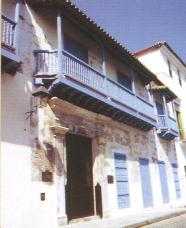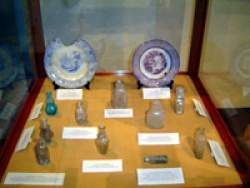 ENCUENTRO ARQUEOLOGICO CON LA HABANA VIEJA.
ENCUENTRO ARQUEOLOGICO CON LA HABANA VIEJA.
Se cumplen treinta dos años de la creación del Gabinete de Arqueologia de la Oficina del Historiador de la ciudad. Desde sus tiempos iniciales, la entidad dedicó buena parte de las investigaciones proyectadas a la búsqueda de aquellos elementos que propiciaran conocer cómo se asentó y creció la capital, en qué lugar fueron establecidos los primeros grupos poblacionales, cuáles eran sus hábitos dietéticos y las costumbres prevalecientes, a fin de obtener un retrato lo más fiel posible de la vida habanera durante la etapa colonial.
Lo anterior condujo entre otras labores, a la realización de excavaciones arqueológicas en lugares añejos de la urbe, dirigidas a obtener información, avanzar en el conocimiento e intentar comprender el quehacer de las sociedades precedentes. Segun el arqueologo Roger Arrazcaeta la Habana Vieja es una verdadera catedral de tesoros arqueologicos, donde aun queda mucho por escudriñar y descubrir.
Precisó que los trabajos acometidos allí a lo largo de tres décadas aportaron abundantes y nuevos conocimientos, referidos –por ejemplo– a las técnicas constructivas y materiales empleados en la edificación de casas en el transcurso de la etapa colonial, tipos de decoraciones murales y pinturas, especies de madera utilizadas en las viviendas, variedad de alimentos, vajillas, e incluso, hasta la procedencia y comercio de los artículos de consumo, particularmente los de cerámica y vidrio.
Aseveró que también pudieron rescatar miles de objetos empleados por las familias habaneras entre los siglos XVI y XIX, lo cual además de facilitar una reconstrucción histórica más cercana al pasado de la ciudad, ha influido en el enriquecimiento del legado cultural cubano.
REVELACIONES NOTABLES
Uno de los hallazgos más notables hechos por los especialistas y técnicos del Gabinete de Arqueología tuvo lugar hace algunos años en el inmueble sito en la calle Mercaderes esquina a Lamparilla (allí radicó la antigua Ferretería de Isasi), cuando en medio de las faenas de restauración de la vivienda en el 2005, apareció un hueco con basura del siglo XVI. Como señala el especialista, al principio hubo duda acerca del uso primario que pudo tener, pues podría tratarse de un hoyo abierto para verter basura doméstica o una cantera de extracción de roca caliza y tierra, rellenada luego con desechos de la actividad humana.
«Luego de analizar la estratigrafía del terreno y el contenido de las cosas descubiertas, llegamos a la conclusión de que se correspondía con la segunda hipótesis planteada y al poco tiempo empezamos las excavaciones», subrayó.
Dada la variedad y el estado de conservación de la mayoría de los objetos hallados, el lugar devino en el sitio arqueológico más importante del siglo XVI conocido hasta el momento en La Habana Vieja.
El listado contempló huesos pertenecientes a varias especies de palomas, patos, flamencos, grullas, gallinas, corderos, cerdos, vacas, además de esqueletos de peces, mejillones, ostras y carapachos de tortugas, dando fe de los alimentos consumidos por los pobladores de la casa y probablemente también de las áreas vecinas.
Una de las novedades más ilustrativas consistió en el primer reporte para toda el área del Caribe de restos del pato doméstico, así como la elevada talla del ganado vacuno introducido desde España, y la localización de un cuerno casi completo de un ejemplar de venado macho adulto, que constituyó la evidencia más temprana de la presencia de dicho animal en nuestra región, acotó Arrazcaeta.
No menos interesante resultó la aparición de dados de hueso para juegos, botones, monedas españolas de los reinados de Carlos II y Juana, y de Felipe II, amuletos contra el «mal de ojos» botijas, porcelana de la Dinastía Ming, y más de 30 tipos de cerámica, procedentes del periodo comprendido de 1519 a 1600.
Igualmente extrajeron un amplio número de las llamadas cerámicas de Tradición Aborigen, empleadas con fines culinarios y hechas por aborígenes asentados en las inmediaciones del poblado de Guanabacoa y en la propia Habana Vieja. Ello muestra que durante el siglo XVI nuestros «indios» convivieron con los demás habitantes citadinos.
Entre los trabajos que se acometen actualmente por el Gabinete de Arqueología, en colaboración con otras instituciones, figuran las excavaciones emprendidas en tramos de la denominada Muralla de Mar, a un costado del Castillo de la Fuerza frente a la Avenida del Puerto, construida por la metrópoli española como parte del sistema defensivo de la urbe. Sobre esa faena que retoma las labores de rescate de tan importante obra, iniciadas originalmente por el Doctor Eusebio Leal en 1984, Arrazcaeta informó que fueron halladas algunas cimentaciones de una antigua pescadería edificada en 1835 y otras estructuras constructivas pertenecientes a la batería de cañones San Francisco Javier.
Los descubrimientos más significativos, comentó, se hicieron en un basurero del siglo XVIII colindante a los restos de la referida Muralla, conformado por tierra muy oscura y rica en carbón de leña, cenizas de cocina, virutas y pedazos de madera de carpintería y materia orgánica, localizado a unos dos metros de profundidad en estado semianaeróbico.
“Tal condición favoreció la conservación de restos muy perecederos, entre ellos piezas de madera torneada de muebles, un carretel de hilo, suelas de zapato de cuero y semillas de guanábana, coco, calabaza, níspero y mamey de Santo Domingo”.
Recuperaron de igual forma fragmentos de vajillas de mayólicas mexicanas de Puebla, cáscaras de huevos, pipas de caolín inglesas para fumar tabaco, nuevas vasijas de cerámica de Tradición Aborigen, mayólicas europeas y algunos tiestos de porcelana china. Dichas piezas ratifican el notable comercio existente en la ciudad en aquella época y el relevante patrimonio arqueológico que aún espera por ser develado bajo el suelo de La Habana Vieja.
 ARCHAEOLOGICAL MEETING WITH THE HAVANA VIEJA”.
ARCHAEOLOGICAL MEETING WITH THE HAVANA VIEJA”.
Thirty-two years have passed since the creation of the Archeology Office of the Historian of the city. From its early days, the entity devoted much of the projected research to the search for those elements that would lead to know how the capital settled and grew, where the first population groups were established, what were their dietary habits and the prevailing customs , in order to obtain a portrait as faithful as possible of Havana life during the colonial period.
This led, among other things, to the carrying out of archaeological excavations in old places in the city, aimed at obtaining information, advancing knowledge and trying to understand the work of the preceding societies. According to the archaeologist Roger Arrazcaeta, Old Havana is a true cathedral of archaeological treasures, where there is still much to be scrutinized and discovered.
He said that the work undertaken there over three decades provided abundant and new knowledge, referred to, for example, the construction techniques and materials used in the construction of houses during the colonial period, types of mural decorations and paintings, wood species used in homes, variety of foods, tableware, and even, until the origin and trade of consumer items, particularly those of ceramics and glass.
He asserted that they were also able to rescue thousands of objects used by Havana families between the 16th and 19th centuries, which in addition to facilitating a historical reconstruction closer to the city’s past, has influenced the enrichment of the Cuban cultural legacy.
NOTABLE REVELATIONS
One of the most remarkable findings made by the specialists and technicians of the Archeology Cabinet took place a few years ago in the building located on Mercaderes street corner to Lamparilla (there was the former hardware store of Isasi), when in the middle of restoration work of the house in 2005, a hole with garbage from the 16th century appeared. As the specialist points out, at first there was doubt about the primary use that could have, since it could be an open pit to dump domestic garbage or a quarry for limestone and earth extraction, then filled with waste from human activity.
“After analyzing the stratigraphy of the terrain and the content of the discovered things, we reached the conclusion that it corresponded to the second hypothesis and soon after we started the excavations,” he said.
Given the variety and state of conservation of most of the objects found, the place became the most important archaeological site of the sixteenth century known until now in Old Havana.
The list included bones belonging to several species of pigeons, ducks, flamingos, cranes, chickens, lambs, pigs, cows, as well as skeletons of fish, mussels, oysters and turtle carapaces, attesting to the food consumed by the inhabitants of the home and probably also from neighboring areas.
One of the most illustrative novelties consisted of the first report for the entire Caribbean area of domestic duck remains, as well as the high size of cattle introduced from Spain, and the location of an almost complete horn of an adult male deer. , which was the earliest evidence of the presence of this animal in our region, said Arrazcaeta.
No less interesting was the appearance of bone dice for games, buttons, Spanish coins of the reigns of Carlos II and Juana, and Felipe II, amulets against the “evil eye” jars, porcelain of the Ming Dynasty, and more than 30 types of ceramics, from the period from 1519 to 1600.
They also extracted a large number of the so-called Aboriginal Tradition ceramics, used for culinary purposes and made by aborigines settled in the vicinity of the town of Guanabacoa and in Old Havana itself. This shows that during the sixteenth century our “Indians”
coexisted with the other inhabitants of the city.
Among the works that are currently undertaken by the Archeology Cabinet, in collaboration with other institutions, are the excavations undertaken in sections of the so-called Muralla del Mar, next to the Castillo de la Fuerza in front of the Avenida del Puerto, built by the Spanish metropolis as part of the defensive system of the city. On this task that resumes the rescue work of this important work, originally started by Dr. Eusebio Leal in 1984, Arrazcaeta reported that some foundations of an old fish market built in 1835 and other construction structures belonging to the battery of San Francisco cannons were found, Javier.
The most significant discoveries, he said, were made in a rubbish dump of the eighteenth century adjoining the remains of the aforementioned wall, consisting of very dark earth rich in charcoal, ashes, wood chips and pieces of the woodwork and organic matter, located about two meters deep in a semianaerobic state.
“Such a condition favored the conservation of very perishable remains, among them pieces of turned wood furniture, a reel of thread, soles of leather shoe and soursop seeds, coconut, pumpkin, medlar, and mamey of Santo Domingo”.
They also recovered fragments of Mexican majolicas from Puebla, egg shells, English kaolin pipes to smoke tobacco, new pottery vessels from the Aboriginal Tradition, European majolicas and some china pots. These pieces confirm the remarkable trade existing in the city at that time and the important archaeological heritage that still awaits being unveiled under the floor of Old Havana.
Agencies/ RHC/ Orfilio Peláez/ Internet Photos/ Arnoldo Varona/ www.TheCubanHistory.com
THE CUBAN HISTORY, HOLLYWOOD.



 < ARCHAEOLOGICAL Meeting with the "HAVANA VIEJA". Photos.
< ARCHAEOLOGICAL Meeting with the "HAVANA VIEJA". Photos.







